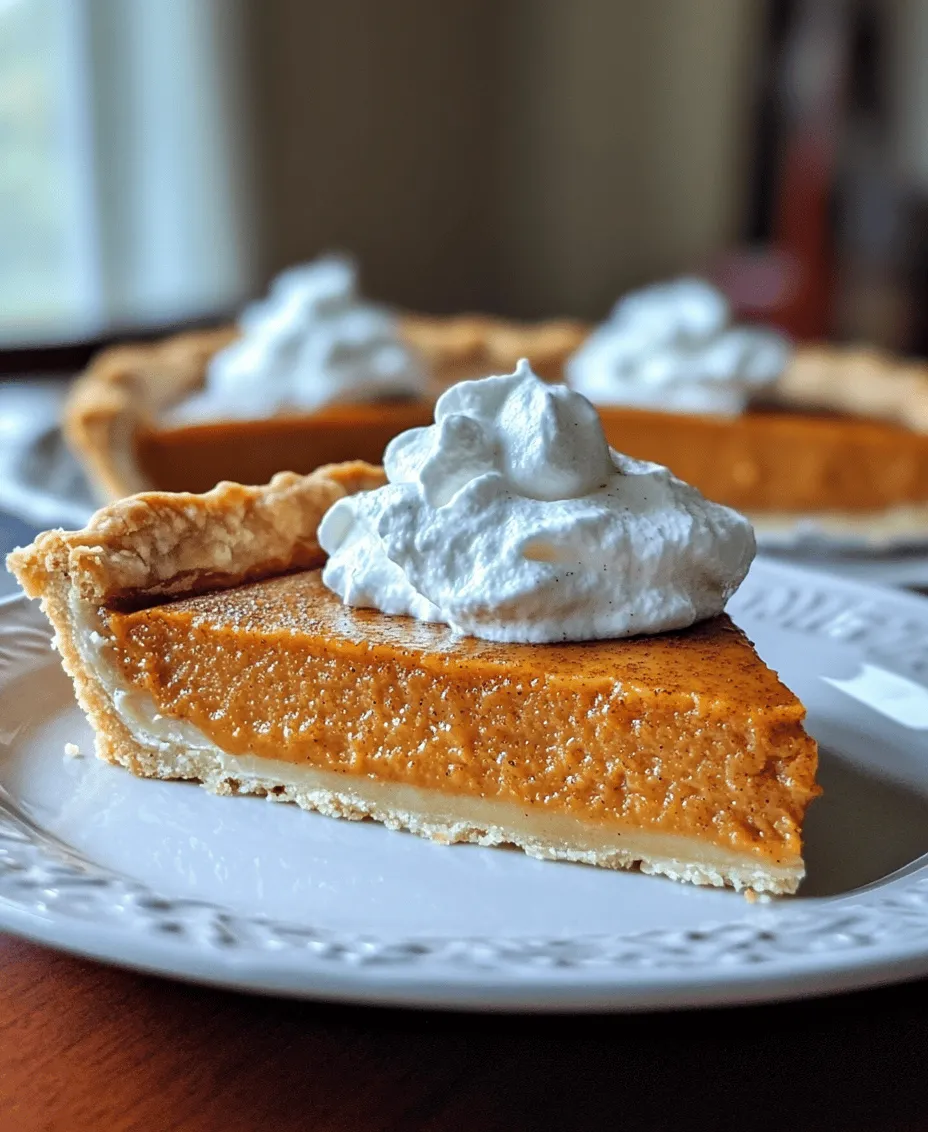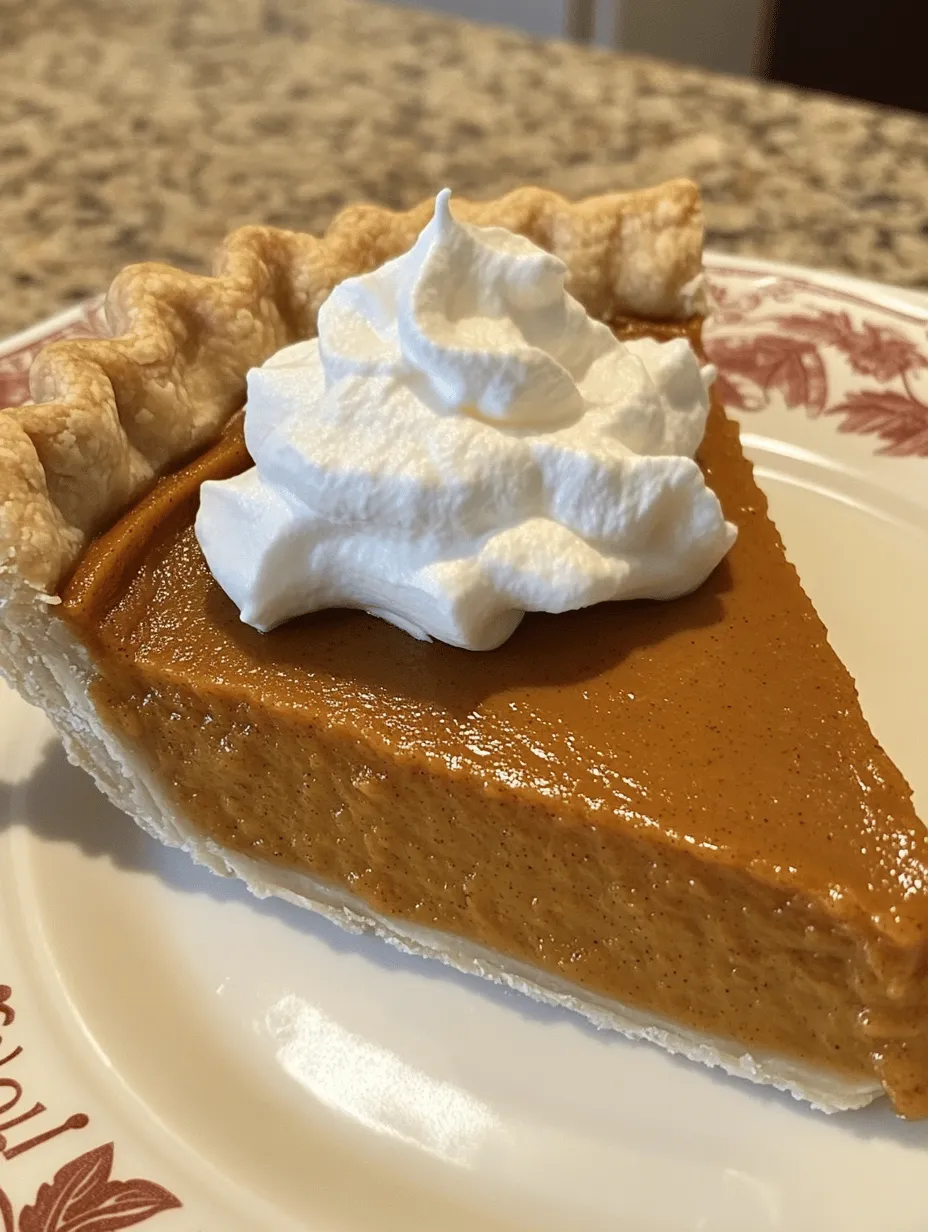Introduction
As the leaves turn golden and the air becomes crisp, the aroma of freshly baked pumpkin pie wafts through homes across America. This beloved dessert has become synonymous with fall, especially during Thanksgiving and other holiday gatherings. The rich, spiced flavor of pumpkin pie not only warms the heart but also evokes a sense of nostalgia, reminding many of cherished family traditions and festive celebrations. With its creamy texture and aromatic spices, it is no surprise that pumpkin pie holds a special place on dessert tables nationwide.
When it comes to baking a classic pumpkin pie, many home cooks can feel intimidated by the prospect of getting it just right. However, fear not! This article presents a foolproof method for crafting the perfect pumpkin pie that will impress your family and friends. Our recipe simplifies the process, ensuring that even novice bakers can create a delicious, beautifully spiced pie that captures the essence of the season.
Understanding Pumpkin Pie
History and Origins of Pumpkin Pie in American Cuisine
Pumpkin pie has a rich history that dates back to the early days of American colonization. The origins of this iconic dessert can be traced to the Native Americans, who cultivated pumpkins long before European settlers arrived. They utilized pumpkins in various dishes, often roasting or boiling them.
The first recorded pumpkin pie recipe appears in a 1651 English cookbook, but it was the early American settlers who adapted and popularized the dish. They would hollow out pumpkins, fill them with milk, spices, and honey, and bake them in hot ashes. This primitive version laid the groundwork for the pumpkin pie we know today. By the 18th century, pumpkin pie had become a staple in American households, particularly during the fall harvest season and Thanksgiving celebrations.
Cultural Significance and Variations of Pumpkin Pie Across Different Regions
Over the years, pumpkin pie has evolved, and various regions have put their unique spin on the classic recipe. In the northeastern United States, for example, it is often served with whipped cream, while in the South, variations may include ingredients like pecans or a splash of bourbon for added depth.
Moreover, pumpkin pie has gained international recognition, inspiring recipes that incorporate local flavors and ingredients. In Canada, for instance, pumpkin pie is also a popular dessert during Thanksgiving, celebrated on a different date than in the U.S. Many families have their secret variations, adding everything from maple syrup to ginger, each reflecting their culinary heritage.
Importance of Using Quality Ingredients for the Best Flavor and Texture
When it comes to baking, especially with a recipe as classic as pumpkin pie, the quality of your ingredients can make all the difference. Using fresh, high-quality ingredients not only enhances the flavor but also contributes to the overall texture of the pie. For instance, fresh eggs provide the necessary binding properties, while pure pumpkin puree offers a richer taste compared to canned pumpkin pie filling, which often contains added sugars and spices.
In this recipe, we emphasize the importance of selecting the best ingredients available. From the pumpkin to the spices, each element plays a crucial role in achieving the perfect balance of flavors that will make your pie a standout dessert.
Ingredients Breakdown
To create our foolproof classic pumpkin pie, we need to gather a selection of key ingredients. Here’s a detailed breakdown of each component and its role in the recipe:
Ingredient List:
– Pumpkin Puree: The star of the show, pumpkin puree is essential for that iconic flavor and texture. It’s best to use pure pumpkin puree made from sugar pumpkins or other varieties specifically meant for baking. Avoid pumpkin pie filling, which often contains added sugars and spices that can alter the taste of your pie.
– Pie Crust: The crust provides the foundation for your pie. You can choose to make your own homemade crust for an authentic taste or opt for a store-bought crust for convenience. We will discuss the merits of each option later in this article.
– Sugar: Granulated sugar sweetens the filling, balancing the natural earthiness of the pumpkin. Brown sugar can also be used for a deeper, caramel-like flavor that complements the spices.
– Spices: A blend of cinnamon, nutmeg, ginger, and clove creates that quintessential pumpkin pie aroma. The right balance of spices is crucial for achieving that warm, comforting flavor profile that defines this dessert.
– Evaporated Milk: This ingredient adds creaminess to the filling without making it overly rich. It helps to create a smooth texture and enhances the overall flavor of the pie.
– Fresh Eggs: Eggs act as a binding agent in the filling, providing structure and helping to set the pie as it bakes. Fresh eggs contribute to a better texture and richer taste.
Homemade vs. Store-Bought Pie Crust
When deciding between homemade and store-bought pie crust, consider the time and effort you are willing to invest. A homemade pie crust, made from scratch, often yields a flakier and more flavorful result. However, if you’re short on time or prefer convenience, a store-bought crust can still produce delightful results.
If you choose to make your own crust, ensure you use cold butter and keep your ingredients chilled to achieve that perfect flaky texture. The crust should be well-chilled before baking to prevent it from shrinking or losing shape in the oven.
The Significance of Using Pure Pumpkin Puree Versus Pumpkin Pie Filling
It’s crucial to differentiate between pure pumpkin puree and pumpkin pie filling. Pure pumpkin puree is made from cooked and pureed pumpkins, free from additives, preservatives, and sweeteners. This allows you to control the sugar content and spices in your pie, resulting in a more customized flavor profile.
Pumpkin pie filling, on the other hand, is pre-seasoned and sweetened, which can lead to an overly sweet and potentially unbalanced pie. For the best results in our foolproof classic pumpkin pie, always opt for pure pumpkin puree.
Analysis of Spices: Why Balance Matters in Achieving the Perfect Flavor Profile
The spices used in pumpkin pie are what elevate it from a simple dessert to a holiday classic. The combination of cinnamon, nutmeg, ginger, and clove creates a warm and inviting flavor that perfectly complements the pumpkin. However, achieving the right balance of spices is essential.
Too much of any one spice—especially the stronger ones like nutmeg or clove—can overpower the pie and detract from the pumpkin’s natural sweetness. Conversely, too little spice can leave the pie tasting bland. Following our recipe will help ensure that the spices are harmoniously blended, resulting in a pie that is both flavorful and aromatic.
Importance of Fresh Eggs and Evaporated Milk in Creating the Pie’s Texture
Fresh eggs serve a dual purpose in our pumpkin pie recipe. They not only help bind the ingredients together but also create a custard-like filling that sets perfectly as it bakes. Fresh eggs contribute to a richer taste and texture compared to older eggs, making them essential for achieving the perfect pie.
Evaporated milk adds an extra layer of creaminess without the heaviness of cream. It provides a smooth texture, allowing the flavors to meld beautifully while preventing the filling from becoming too dense. Together, these ingredients create the ideal filling that is both rich and light, making each slice a delight.
Preparing the Perfect Pie Crust
Step-by-Step Guide to Making a Homemade Pie Crust
If you decide to make a homemade pie crust, follow these steps for guaranteed success:
1. Gather Your Ingredients: You’ll need all-purpose flour, cold unsalted butter, salt, sugar, and ice water.
2. Mix Dry Ingredients: In a large mixing bowl, combine 1 ½ cups of all-purpose flour, ¼ teaspoon of salt, and 1 tablespoon of sugar. Whisk together until evenly combined.
3. Cut in Butter: Dice ½ cup of cold unsalted butter into small cubes. Using a pastry cutter or your fingertips, cut the butter into the flour mixture until it resembles coarse crumbs. Be careful not to overwork the dough—some pea-sized pieces of butter should remain.
4. Add Ice Water: Gradually add ice water, one tablespoon at a time, mixing until the dough just comes together. You may need about 4-6 tablespoons, but add it slowly to avoid making the dough too wet.
5. Form the Dough: Turn the dough out onto a lightly floured surface and shape it into a disk. Wrap it in plastic wrap and chill in the refrigerator for at least 1 hour.
6. Roll Out the Crust: After chilling, roll the dough out on a floured surface until it’s about 1/8 inch thick. Carefully transfer it to a 9-inch pie pan, pressing it gently into the bottom and sides.
7. Trim and Crimp Edges: Trim any overhanging dough, leaving about 1 inch, and fold it under itself to create a thicker edge. Crimp the edges with your fingers or a fork for a decorative touch.
8. Chill Again: Chill the crust for another 30 minutes before baking. This helps prevent shrinking during the baking process.
Tips for Achieving the Perfect Texture and Flavor in a Pie Crust
– Use Cold Ingredients: Keep all ingredients, especially butter and water, as cold as possible. This ensures a flaky texture.
– Don’t Overwork the Dough: Overworking the dough can lead to a tough crust. Mix just until combined.
– Chilling is Key: Allow the crust to chill adequately before baking. This helps the fat to solidify, resulting in a flaky texture.
Common Pitfalls to Avoid When Preparing Pie Crust
– Ignoring the Chill Time: Skipping the chilling steps can lead to a crust that shrinks and loses shape.
– Using Warm Ingredients: Warm butter or water can melt the fat prematurely, resulting in a dense crust.
– Soggy Bottoms: To avoid a soggy crust, consider pre-baking (blind baking) the crust for about 10 minutes before adding your filling.
Chilling the Crust: Why It Matters and How It Affects the Final Result
Chilling the crust is essential for achieving that flaky texture. When the dough is chilled, the fat becomes firm, and when baked, it melts, creating steam that separates the layers of dough, resulting in a light and flaky crust. Additionally, chilling helps to relax the gluten in the flour, preventing the crust from becoming tough during baking.
By following these guidelines for creating the perfect pie crust, you’ll be well on your way to making a foolproof classic pumpkin pie that will delight everyone at your holiday table. The next step will involve preparing the pumpkin filling, which promises to be as straightforward and rewarding as making the crust. Stay tuned for detailed instructions on creating the perfect pumpkin filling!

Importance of Seasoning and Balancing Flavors in the Pumpkin Mixture
Creating the perfect pumpkin pie is as much about the spices and flavors as it is about the pumpkin itself. The classic combination of cinnamon, nutmeg, ginger, and allspice transforms the pumpkin into a warm and inviting filling. Each spice plays a unique role: cinnamon adds warmth, nutmeg offers a hint of sweetness, ginger provides a slight kick, and allspice rounds out the profile with earthy notes.
To achieve a well-balanced flavor, it’s essential to season your pumpkin mixture to taste. Start by adding the spices in small amounts, then adjust based on your preference. Always remember that the flavors will deepen as the pie bakes, so err on the side of caution. A pinch of salt is crucial too; it enhances the sweetness of the pumpkin while suppressing any bitterness.
Techniques for Achieving a Perfectly Spiced Pumpkin Filling
To ensure your pumpkin filling is perfectly spiced, consider the following techniques:
1. Use Fresh Spices: Ground spices can lose potency over time, so always opt for fresh spices for maximum flavor impact.
2. Toast Your Spices: Briefly toasting spices in a dry skillet before adding them to the mixture can enhance their flavors and aroma significantly.
3. Incorporate Vanilla: A splash of vanilla extract can elevate the flavor profile, adding depth that complements the pumpkin.
4. Adjust Sweetness: Depending on your taste, you can modify the amount of sugar or sweetener. Taste the mixture before pouring it into the crust, and adjust as necessary.
5. Experiment with Flavor Additions: Consider adding a splash of bourbon or maple syrup for a unique twist that mingles beautifully with the spices.
Baking the Pie
Once your filling is perfectly spiced and mixed, it’s time to bake the pie. Follow these step-by-step instructions for a flawless baking experience:
1. Preheat Your Oven: Start by preheating your oven to 425°F (220°C). This high temperature helps set the crust.
2. Prepare the Crust: If you haven’t already, roll out your pie crust and place it in a 9-inch pie pan. Crimp the edges and poke a few holes in the bottom to prevent bubbling.
3. Pour in the Filling: Carefully pour the prepared pumpkin filling into the crust, ensuring not to overfill.
4. Bake the Pie: Place the pie on the middle rack of the preheated oven. Bake at 425°F for 15 minutes to give the crust a head start.
5. Lower the Temperature: After 15 minutes, reduce the oven temperature to 350°F (175°C) and continue baking for another 30 to 40 minutes. This allows the filling to set without overcooking the crust.
6. Knife Test for Doneness: To check if the pie is properly baked, insert a knife into the center of the filling. If it comes out clean or with just a few moist crumbs, the pie is ready. If it’s still runny, return it to the oven for an additional 5 to 10 minutes.
7. Visual Cues: Keep an eye on the edges of the crust; they should be golden brown. The filling should appear set with a slight wobble in the center.
Cooling and Serving the Pie
Allowing your pumpkin pie to cool is a crucial step. As it cools, the filling will continue to set, resulting in a slice that holds its shape.
1. Cooling Time: Let the pie cool at room temperature for at least 2 hours. If you’re not serving it immediately, cover it loosely with plastic wrap and refrigerate.
2. Serving Suggestions: The classic way to serve pumpkin pie is with a generous dollop of freshly whipped cream. The creamy texture and sweetness perfectly balance the spicy filling.
3. Creative Serving Ideas: For a more elegant presentation, consider topping the pie with caramel sauce, toasted pecans, or even a sprinkle of finely grated dark chocolate. These additions can elevate the traditional pie into a gourmet dessert.
4. Storing Leftover Pie: If you have leftovers, store the pie in the refrigerator for up to 4 days. Make sure to cover it with plastic wrap or foil to keep it fresh. For longer storage, you can freeze slices wrapped in plastic, then foil for up to 2 months.
Common Mistakes and Solutions
Baking pumpkin pie can come with its own set of challenges. Here are some common mistakes and their solutions:
1. Soggy Crust: This is a frequent issue. To prevent it, make sure to blind-bake your crust if using a homemade version. You can also sprinkle some cornstarch or breadcrumbs on the bottom of the crust before adding the filling to absorb moisture.
2. Runny Filling: This can happen if the filling is undercooked or if too many liquid ingredients are added. Always follow the recipe closely, ensuring your pumpkin puree is thick and not overly watery.
3. Crust Burning: If your crust is browning too quickly, cover the edges with strips of aluminum foil midway through baking to prevent burning while allowing the filling to cook through.
4. Over-spiced Filling: If you’ve added too much spice, it’s tough to fix. Always start with less, as you can add more to taste. If it’s too strong, consider serving it with extra whipped cream to balance it out.
5. Impatience: Many bakers make the mistake of cutting into the pie too soon. Allowing it to cool properly is essential for achieving the perfect slice.
Nutritional Information and Variations
A classic pumpkin pie is not only delicious but can also be relatively nutritious. Here’s a general breakdown:
– Calories: Approximately 320 calories per slice (1/8 of a 9-inch pie)
– Fat: 15g
– Carbohydrates: 45g
– Protein: 4g
– Fiber: 2g
– Sugars: 20g
For those seeking healthier variations, consider the following tips:
1. Alternative Sweeteners: Swap out granulated sugar for healthier alternatives like honey, maple syrup, or coconut sugar.
2. Dairy-Free Options: Use coconut milk or almond milk instead of heavy cream for a dairy-free version of the filling.
3. Flavor Variations: To mix things up, try adding a layer of chocolate ganache at the bottom of the crust or swirl in some caramel sauce into the pumpkin filling before baking for a decadent twist.
Conclusion
Baking a classic pumpkin pie is a rewarding experience that brings joy and warmth to any gathering. This foolproof recipe ensures that bakers of all skill levels can create a delicious pie that embodies the flavors of fall.
The best part about making pumpkin pie is the opportunity to share it with loved ones, creating memories over a dessert that has stood the test of time. As you embark on your baking journey, remember to enjoy every step of the process, from mixing the spices to serving the finished pie. Your kitchen will soon be filled with the comforting aroma of pumpkin and spice, making it an experience worth savoring. So roll up your sleeves, gather your ingredients, and dive into the delightful world of pumpkin pie making!

